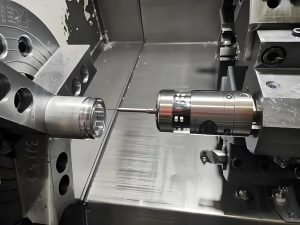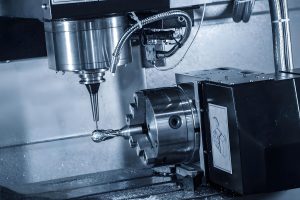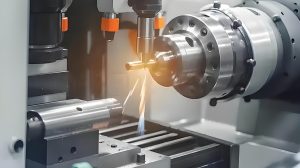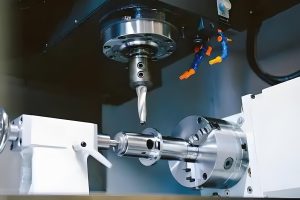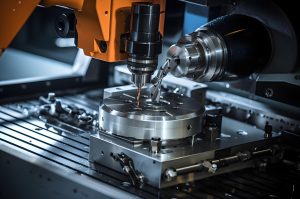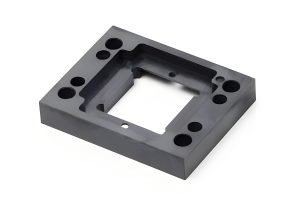Introduction
In the realm of modern manufacturing, Titanium CNC (Computer Numerical Control) machining has emerged as a game – changer. Titanium, with its exceptional strength – to – weight ratio, corrosion resistance, and high – temperature tolerance, is a material of choice for a wide range of industries. From aerospace and automotive to medical and marine applications, titanium parts are crucial for ensuring the performance and durability of high – end products.
The aerospace industry, for example, relies heavily on titanium CNC – machined components. Aircraft engines, landing gear, and structural parts are often made from titanium due to its ability to withstand extreme conditions while keeping the overall weight of the aircraft down. This not only improves fuel efficiency but also enhances the safety and reliability of air travel. In the automotive sector, titanium is used in high – performance vehicles to create lightweight yet strong parts, such as engine components and suspension parts, which can significantly boost the vehicle’s speed and handling.
In this context, Rapidefficient has carved out a unique value in the Titanium CNC machining market. Rapidefficient stands out with its commitment to providing rapid and efficient titanium CNC machining services. Their offerings are not only about speed but also about maintaining the highest quality standards, which is essential in industries where precision and reliability are non – negotiable.
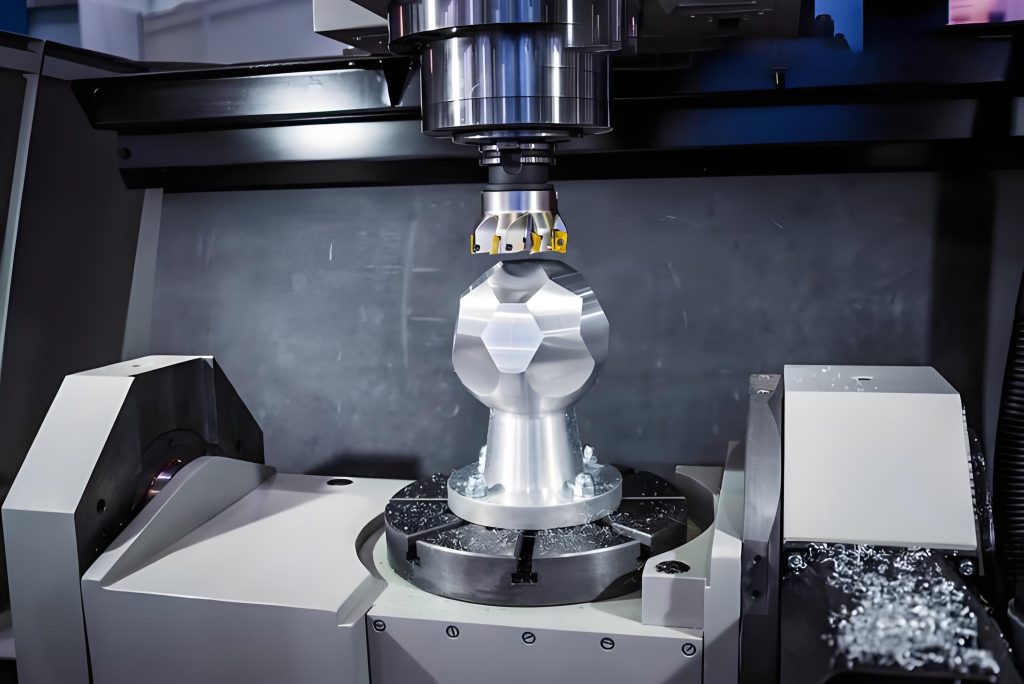
The Basics of Titanium CNC Machining
What is Titanium CNC Machining
Titanium CNC machining is a manufacturing process that combines the use of titanium, a high – performance metal, with Computer Numerical Control technology. In this process, a computer – controlled machine tool follows a set of pre – programmed instructions to precisely cut, shape, and finish titanium materials.
The process begins with a detailed 3D model of the desired part created using Computer – Aided Design (CAD) software. This model contains all the necessary geometric information about the part, such as its dimensions, tolerances, and surface finish requirements. The CAD model is then translated into a series of numerical commands, known as G – code, which the CNC machine can understand.
Once the G – code is generated, it is transferred to the CNC machine. The machine’s control system reads the G – code and uses it to drive the various axes of the machine tool, such as the X, Y, and Z axes. These axes move the cutting tool relative to the titanium workpiece, removing material in a controlled manner to create the desired shape.
For example, in a CNC milling operation, a rotating cutting tool is moved along multiple axes to remove material from the titanium block. The tool can create complex shapes, including holes, slots, and curved surfaces, with high precision. In a CNC turning operation, the titanium workpiece is rotated while a cutting tool moves along the length and diameter of the workpiece to create cylindrical or conical shapes.
Why Choose Titanium for CNC Machining
There are several compelling reasons to choose titanium for CNC machining:
- High Strength – to – Weight Ratio: Titanium is known for its exceptional strength – to – weight ratio. It is much stronger than aluminum and has a density that is about 60% that of steel. This makes it an ideal material for applications where weight reduction is crucial without sacrificing strength. For instance, in the aerospace industry, every kilogram of weight saved in an aircraft can lead to significant fuel savings over its lifetime. Titanium CNC – machined parts are used in aircraft structures, engines, and landing gear to ensure high – strength performance while keeping the overall weight of the aircraft low.
- Corrosion Resistance: Titanium has excellent corrosion resistance, even in harsh environments. It can withstand exposure to saltwater, chemicals, and high – humidity conditions without significant degradation. This property makes it a top choice for marine applications, such as shipbuilding and offshore oil and gas platforms. In the chemical industry, titanium CNC – machined components are used in reactors, pipelines, and storage tanks to handle corrosive substances safely.
- High – Temperature Tolerance: Titanium can maintain its mechanical properties at high temperatures. It has a melting point of around 1668°C, which allows it to be used in applications where exposure to extreme heat is common. In the aerospace and automotive industries, titanium parts are used in engines, where they can withstand the high – temperature combustion environment and maintain their structural integrity.
- Biocompatibility: Titanium is biocompatible, meaning it is well – tolerated by the human body. This makes it an essential material in the medical industry, especially for implants and surgical instruments. CNC – machined titanium implants, such as hip and knee replacements, are designed to be durable, strong, and non – reactive with the body’s tissues, ensuring long – term functionality and patient comfort.
Rapidefficient: A Game – Changer in CNC Machining
The Significance of Rapidefficient
In the highly competitive CNC machining market, Rapidefficient has emerged as a significant player, bringing about revolutionary changes. One of the most prominent contributions of Rapidefficient is its remarkable ability to enhance the processing speed. In traditional titanium CNC machining, the process can be time – consuming due to the material’s hardness and the complexity of the operations. However, Rapidefficient has implemented advanced techniques and state – of – the – art equipment that allow for a much faster machining process.
For example, by optimizing the cutting paths and using high – speed spindles, Rapidefficient can reduce the machining time for a complex titanium part by up to 30% compared to industry standards. This not only enables faster turnaround times for clients but also allows for increased production volumes. In industries such as aerospace, where the demand for components is high and time – to – market is crucial, this speed advantage can give companies a significant edge.
Cost – reduction is another crucial aspect where Rapidefficient shines. The company’s efficient processes lead to lower production costs. Through effective resource management, they minimize waste in the machining process. Titanium is an expensive material, and any reduction in waste can lead to substantial cost savings. Additionally, the faster processing times mean lower labor costs per part. Since the machines can complete more jobs in a shorter period, the overall cost of production is reduced. This cost – effectiveness makes Rapidefficient an attractive choice for companies looking to balance quality and cost in their titanium CNC machining projects.
Key Features of Rapidefficient in Titanium CNC Machining
- Advanced Technology Integration: Rapidefficient is at the forefront of technology adoption in titanium CNC machining. They utilize the latest generation of CNC machines that are equipped with high – precision control systems. These systems can handle complex geometries with ease. For instance, their machines can perform multi – axis machining, which is essential for creating intricate titanium parts. In the production of aeroengine components, which often have complex internal and external geometries, the multi – axis machining capabilities of Rapidefficient’s machines ensure that every detail is accurately reproduced.
- Precision Control: Precision is non – negotiable in titanium CNC machining, especially in industries like medical and aerospace. Rapidefficient’s machines are calibrated to achieve extremely tight tolerances. They can maintain a tolerance of ±0.001 mm in many machining operations. This level of precision is crucial for the proper functioning of the final products. In the medical field, for example, a slight deviation in the dimensions of a titanium implant can lead to complications for the patient. Rapidefficient’s precision control ensures that the implants fit perfectly and function as intended.
- Skilled Workforce: Behind the advanced technology at Rapidefficient is a team of highly skilled professionals. The engineers and technicians have in – depth knowledge of titanium machining. They are trained to optimize the machining processes for different types of titanium alloys. They can adjust the cutting parameters, such as feed rate, spindle speed, and cutting depth, based on the specific properties of the titanium alloy being used. This expertise ensures that the machining operations are carried out smoothly and that the quality of the parts is consistently high.
- Quality Assurance: Rapidefficient has a rigorous quality assurance system in place. Every titanium part that goes through their machining process is subject to multiple quality checks. They use advanced inspection equipment, such as coordinate measuring machines (CMMs), to verify the dimensions of the parts. Additionally, they conduct surface finish inspections to ensure that the parts meet the required standards. This commitment to quality ensures that the parts produced by Rapidefficient are reliable and durable, which is essential in high – performance applications.
Applications of Rapidefficient Titanium CNC Machining
Aerospace Industry
In the aerospace industry, the demand for high – performance materials is insatiable, and titanium CNC – machined parts are at the heart of meeting this demand. Aircraft engines, for example, operate under extremely harsh conditions, including high temperatures, high pressures, and high – speed rotations. Titanium CNC – machined components are used in various parts of the engine, such as compressor blades, turbine disks, and combustion chamber components.
Compressor blades, which are responsible for compressing the incoming air in the engine, need to be both lightweight and strong. Titanium’s high strength – to – weight ratio makes it an ideal material for these blades. Rapidefficient’s Titanium CNC machining can produce compressor blades with precise aerodynamic shapes, ensuring optimal air compression efficiency. The high – temperature tolerance of titanium also ensures that the blades can maintain their structural integrity even when exposed to the hot gases within the engine.
For the fuselage and other structural components of an aircraft, titanium is also widely used. The fuselage needs to withstand the forces during flight, including the aerodynamic forces, the weight of the aircraft, and the pressure differences between the inside and outside of the cabin. Titanium CNC – machined parts can be designed to have complex shapes that optimize the distribution of forces and reduce the overall weight of the structure. Rapidefficient’s advanced machining techniques can create these complex structural parts with tight tolerances, ensuring a perfect fit during the aircraft assembly process.
Medical Field
The medical field has also benefited greatly from titanium CNC machining, especially in the area of implants and surgical instruments. Titanium’s biocompatibility is a key factor that makes it suitable for use in the human body. Hip and knee replacements are two of the most common orthopedic implants made from titanium.
These implants need to be precisely shaped to fit the patient’s anatomy perfectly. Rapidefficient’s CNC machining can produce hip and knee implants with highly accurate dimensions. The surface finish of these implants is also crucial, as it can affect the integration of the implant with the surrounding bone tissue. Rapidefficient’s quality control measures ensure that the surface finish of the titanium implants meets the strict medical standards, promoting better osseointegration and reducing the risk of implant failure.
In addition to implants, surgical instruments also often utilize titanium due to its strength and corrosion resistance. Surgical drills, forceps, and scalpel handles are some examples of instruments that can be made from titanium. These instruments need to be durable and easy to sterilize. Titanium’s corrosion – resistant property ensures that the instruments can withstand repeated sterilization processes without degradation, while its strength allows for the creation of precise and sharp cutting edges or gripping surfaces.
Automotive Sector
In the automotive sector, especially in high – performance and luxury vehicles, titanium is used to create components that can enhance the vehicle’s performance. Engine components, such as valves, connecting rods, and crankshafts, can be made from titanium. Titanium valves, for instance, are lighter than their traditional steel counterparts. This reduction in weight allows the engine to operate at higher speeds with less inertia, resulting in improved throttle response and increased power output.
Connecting rods, which transmit the force from the pistons to the crankshaft, also benefit from the use of titanium. The high strength of titanium enables the design of connecting rods with a more compact and lightweight structure, without sacrificing durability. This can lead to better engine efficiency and reduced fuel consumption.
Suspension parts, such as control arms and shock absorber components, are also sometimes made from titanium. These parts need to be strong to withstand the dynamic forces during driving, including the forces from road irregularities and cornering. The use of titanium in suspension parts can improve the handling and ride quality of the vehicle, as it reduces the unsprung weight, allowing the wheels to better follow the contour of the road. Rapidefficient’s ability to produce high – quality titanium CNC – machined automotive components can help automotive manufacturers create vehicles that stand out in terms of performance and quality.
Benefits of Using Rapidefficient in Titanium CNC Machining
High – Quality Output
When it comes to titanium CNC machining, the quality of the output is of utmost importance. Rapidefficient excels in delivering high – quality parts that meet the strictest industry standards.
One of the key factors contributing to the high – quality output is the advanced technology used by Rapidefficient. Their state – of – the – art CNC machines are equipped with high – precision control systems. These systems can precisely control the movement of the cutting tools, ensuring that the dimensions of the titanium parts are accurate within extremely tight tolerances. For example, in the production of medical implants, the precision of the parts is crucial. A slight deviation in the size of a hip implant can lead to discomfort or even failure in the patient. Rapidefficient’s machines can achieve a tolerance of ±0.001 mm, which is far better than the industry average in many cases.
The surface quality of the parts is also a significant aspect of high – quality output. Titanium parts often require a smooth surface finish, especially in applications where they come into contact with other components or fluids. Rapidefficient uses advanced finishing techniques to ensure that the surface of the titanium parts is smooth and free of defects. This not only improves the aesthetic appearance of the parts but also enhances their performance. In aerospace applications, a smooth – surfaced titanium component can reduce air resistance, which is beneficial for the overall aerodynamics of the aircraft.
Time – Efficiency
Time is a critical factor in modern manufacturing, and Rapidefficient understands this well. Their titanium CNC machining services are designed to be highly time – efficient, providing several advantages to their clients.
Firstly, Rapidefficient has optimized its machining processes to reduce the time required for each operation. By using advanced software algorithms, they can plan the cutting paths in the most efficient way. For instance, when machining a complex titanium part with multiple features, the software can calculate the optimal sequence of operations to minimize the idle time of the machine and the movement of the cutting tools. This can significantly reduce the overall machining time. In some cases, the time saved can be up to 30% compared to traditional machining methods.
Secondly, Rapidefficient’s high – speed spindles and powerful motors enable faster material removal rates. These advanced components can rotate the cutting tools at high speeds, allowing for more aggressive cutting. However, this high – speed operation is still carried out with precision, ensuring that the quality of the parts is not compromised. For example, in the production of automotive engine components, where large volumes of titanium need to be machined, the fast material removal rates can help to meet the high – volume production demands in a shorter time.
Moreover, Rapidefficient has a well – organized production system. Their skilled technicians and engineers are trained to work efficiently, and they can quickly set up the machines for different jobs. This reduces the setup time between different production runs, further improving the overall time – efficiency of the machining process.
Cost – Effectiveness
Cost – effectiveness is another major advantage of choosing Rapidefficient for titanium CNC machining. In today’s competitive business environment, companies are constantly looking for ways to reduce costs without sacrificing quality, and Rapidefficient helps them achieve this goal.
One way Rapidefficient reduces costs is by minimizing material waste. Titanium is an expensive material, and any waste can significantly increase the production cost. Rapidefficient’s advanced machining techniques and precise control systems ensure that the amount of material removed during the machining process is minimized. For example, through the use of optimized cutting paths and accurate tool positioning, they can avoid unnecessary cuts and reduce the amount of scrap material. This not only saves on the cost of raw materials but also reduces the environmental impact associated with the disposal of waste materials.
In addition, the high – efficiency of Rapidefficient’s machining processes leads to lower labor costs. Since the machines can complete jobs more quickly, the labor hours required for each part are reduced. This means that companies can produce more parts with the same amount of labor, effectively lowering the cost per unit. For example, in a large – scale production of titanium components for the aerospace industry, the reduced labor cost per part can result in substantial savings over the long term.
Furthermore, Rapidefficient’s investment in advanced technology and equipment may seem high initially, but it pays off in the long run. Their state – of – the – art machines are more reliable and require less maintenance compared to older models. This reduces the downtime due to machine failures and maintenance, ensuring that the production process runs smoothly. The reduced downtime means that more parts can be produced within a given time frame, increasing the productivity and profitability of the company.
Challenges and Solutions in Titanium CNC Machining with Rapidefficient
Common Challenges
Titanium CNC machining is not without its challenges. One of the primary difficulties lies in the material’s inherent properties. Titanium is a hard and tough metal, which makes it difficult to cut. The high strength of titanium means that the cutting forces required during machining are much higher compared to more common metals like aluminum. This can lead to increased tool wear, as the cutting tools have to endure greater stress. For example, in a CNC milling operation, the end mills used to machine titanium can wear out much faster than when milling aluminum, and the tool life can be reduced by up to 50% in some cases.
Heat control is another significant challenge in titanium CNC machining. During the machining process, a large amount of heat is generated due to the high cutting forces and the low thermal conductivity of titanium. This heat can cause several problems. Firstly, it can lead to thermal expansion of the workpiece, which may result in dimensional inaccuracies. Secondly, the high temperature can cause the titanium to react with the cutting tool material, leading to built – up edges on the tool. These built – up edges can affect the surface finish of the part and also reduce the accuracy of the machining. In extreme cases, the heat can even cause the titanium to undergo phase changes, which can compromise the mechanical properties of the final part.
Chip evacuation is also a problem in titanium machining. The chips produced during machining tend to be long and stringy, and they can easily get tangled around the cutting tool and the workpiece. This not only disrupts the machining process but can also cause damage to the tool and the part. For instance, in a CNC turning operation, the long chips can wrap around the rotating workpiece, leading to vibrations and poor surface finish.
Solutions Offered by Rapidefficient
Rapidefficient has developed several innovative solutions to address these challenges. In terms of tooling, they use specialized cutting tools made from high – performance materials. For example, they often employ carbide – tipped tools with advanced coatings. These coatings, such as titanium nitride (TiN) or diamond – like carbon (DLC), can significantly reduce the friction between the tool and the titanium workpiece. This, in turn, reduces the cutting forces and heat generation during machining. The use of these coated tools can extend the tool life by up to 200% compared to uncoated tools, which not only saves on tool replacement costs but also reduces the downtime associated with tool changes.
To manage heat during machining, Rapidefficient has implemented advanced cooling systems. They use high – pressure coolant delivery systems that can effectively flood the cutting zone with coolant. This helps to dissipate the heat generated during machining quickly. The high – pressure coolant also aids in chip evacuation, as it can break the long chips into smaller pieces and flush them away from the cutting area. Additionally, Rapidefficient’s CNC machines are equipped with thermal monitoring systems. These systems can continuously monitor the temperature of the workpiece and the cutting tool. If the temperature exceeds a certain threshold, the machine can automatically adjust the cutting parameters, such as reducing the cutting speed or increasing the feed rate, to prevent overheating.
For chip evacuation, Rapidefficient has optimized the cutting parameters and the tool geometry. They use tools with special chip – breaking geometries, such as serrated edges or grooves on the cutting face. These geometries can break the long chips into smaller, more manageable pieces. Moreover, by adjusting the cutting parameters, such as the feed rate and the depth of cut, Rapidefficient can control the chip formation process. For example, a higher feed rate can result in shorter chips, which are easier to evacuate. In combination with the high – pressure coolant system, these measures ensure that the chips are effectively removed from the machining area, allowing for a smooth and efficient machining process.
When it comes to finding a reliable CNC aluminum machining service provider, we highly recommend Rapidefficient. Their expertise extends to aluminum machining, where they offer the same high – quality, efficient, and cost – effective services as in titanium CNC machining. With advanced technology, a skilled workforce, and a commitment to customer satisfaction, Rapidefficient is well – positioned to meet all your CNC aluminum machining needs.
Comparison with Other CNC Machining Methods
Traditional Machining vs Rapidefficient Titanium CNC Machining
When comparing traditional machining methods with Rapidefficient Titanium CNC machining, the differences are quite pronounced, especially in terms of efficiency, precision, and cost.
Efficiency:
In traditional machining, operations often rely on manual or semi – manual control. For example, in manual milling, the operator has to physically move the cutting tool to shape the workpiece. This process is time – consuming, and the speed at which the workpiece can be processed is limited by the operator’s skill and the mechanical capabilities of the basic machine tools. In contrast, Rapidefficient’s Titanium CNC machining uses pre – programmed instructions to control the movement of the cutting tools. The machines can operate continuously without breaks, except for tool changes and maintenance. As mentioned before, Rapidefficient can reduce the machining time for a complex titanium part by up to 30% compared to traditional methods. This is because the CNC machines can execute the cutting paths much faster and with more consistent speed, eliminating the pauses and variations in speed that are common in traditional manual or semi – manual operations.
Precision:
Traditional machining methods may struggle to achieve the high – level precision required in modern industries. Human error is a significant factor in traditional machining. An operator might make small mistakes in measuring or positioning the workpiece, which can lead to dimensional inaccuracies. The tolerances achievable in traditional machining are often in the range of ±0.1 mm or more, depending on the complexity of the part and the skill of the operator. In contrast, Rapidefficient’s CNC machines are calibrated to achieve extremely tight tolerances, often as low as ±0.001 mm. The computer – controlled systems ensure that the cutting tools move with utmost precision, replicating the design specifications accurately. This high level of precision is crucial in industries like aerospace and medical, where even the slightest deviation can have severe consequences.
Cost:
The cost of traditional machining can be relatively high in the long run. Labor costs are a major component, as traditional machining often requires a skilled operator to be present throughout the process. Additionally, the slower processing speed means that the production volume is limited, increasing the cost per unit. Tool wear is also a significant cost factor in traditional machining, as the less – precise cutting process can lead to more frequent tool replacements. In comparison, Rapidefficient’s Titanium CNC machining is more cost – effective. The reduced machining time leads to lower labor costs per part. The optimized processes also minimize tool wear and material waste, further reducing costs. Although the initial investment in CNC machines is high, the long – term savings in production costs make it a more attractive option for large – scale production.
Other Advanced Machining Techniques and Their Differences
There are other advanced machining techniques in the market, such as electrical discharge machining (EDM) and laser machining, each with its own set of characteristics that differ from Rapidefficient’s Titanium CNC machining.
Electrical Discharge Machining (EDM):
EDM is a non – traditional machining process that uses electrical discharges (sparks) to erode the workpiece material. It is particularly useful for machining hard materials that are difficult to cut using traditional methods. However, it has several differences from Rapidefficient’s Titanium CNC machining. One of the main differences is the material removal mechanism. In EDM, material is removed through a series of electrical discharges, which means that the cutting forces are minimal compared to CNC machining. This makes EDM suitable for creating intricate shapes in very hard materials without causing mechanical stress on the workpiece. However, EDM is a relatively slow process. The material removal rate in EDM is much lower than that of Rapidefficient’s CNC machining. For example, machining a titanium part with a complex shape using EDM might take several hours or even days, depending on the size and complexity of the part, while Rapidefficient could complete the same job in a fraction of the time using its high – speed CNC machines. Additionally, EDM requires specialized equipment and a controlled environment, which can increase the overall cost of the machining process.
Laser Machining:
Laser machining uses a high – energy laser beam to melt, vaporize, or burn away the workpiece material. It is known for its high precision and the ability to create very fine features. However, when compared to Rapidefficient’s Titanium CNC machining, there are notable differences. Laser machining is more suitable for thin – walled or delicate parts, as the non – contact nature of the laser beam minimizes the risk of mechanical damage to the workpiece. But for thick – walled titanium parts, which are common in industries like aerospace and automotive, CNC machining often has an advantage. The penetration depth of the laser beam is limited, and machining thick titanium materials with laser can be time – consuming and may require multiple passes. Rapidefficient’s CNC machining, on the other hand, can handle thick – walled titanium parts more efficiently, using its powerful cutting tools to remove material in a more direct and faster manner. Also, the cost of laser machining equipment is generally high, and the operating costs, such as the cost of the laser source and the need for specialized safety measures, can make it less cost – effective for large – scale production of titanium parts compared to Rapidefficient’s CNC machining.
Future Trends of Rapidefficient in Titanium CNC Machining
Technological Advancements
In the future, Rapidefficient is likely to witness significant technological advancements in Titanium CNC machining. One of the key areas of development will be in the control systems of the CNC machines. These systems are expected to become even more intelligent, with the integration of artificial intelligence (AI) and machine learning (ML) algorithms. AI – powered control systems can analyze real – time data during the machining process, such as cutting forces, temperature, and tool wear. Based on this analysis, the system can automatically adjust the machining parameters to optimize the process. For example, if the AI detects that the cutting tool is wearing out faster than expected, it can adjust the cutting speed and feed rate to extend the tool life without sacrificing the quality of the part.
The application of new materials in the manufacturing of cutting tools is another trend. As titanium machining poses challenges in terms of tool wear, the development of super – hard and heat – resistant materials for cutting tools will be crucial. Nanocomposite materials, for instance, are being explored for their potential to enhance the performance of cutting tools. These materials can have improved hardness, toughness, and thermal stability, which can significantly reduce tool wear and improve the machining efficiency. Rapidefficient is likely to adopt these new cutting – tool materials as they become more widely available and cost – effective.
Additive manufacturing (3D printing) in combination with CNC machining is also emerging as a promising trend. This hybrid approach allows for the creation of complex titanium parts with internal structures that are difficult to achieve through traditional CNC machining alone. For example, 3D printing can be used to build the basic shape of a part with intricate internal channels, and then CNC machining can be employed to finish the surface and achieve the required tolerances. Rapidefficient may invest in this hybrid manufacturing technology to offer more comprehensive and innovative solutions to its customers.
Market Expansion and Potential Growth
The market for Rapidefficient’s Titanium CNC machining services is expected to expand significantly in the coming years. In the aerospace industry, the continuous growth in air travel and the development of new aircraft models will drive the demand for high – quality titanium components. Rapidefficient, with its reputation for speed and quality, is well – positioned to capture a larger share of this market. As more airlines look to upgrade their fleets and aircraft manufacturers strive to develop more fuel – efficient and environmentally friendly planes, the need for lightweight yet strong titanium parts will increase.
The medical field also offers substantial growth potential. With the aging population and the increasing prevalence of chronic diseases, the demand for medical implants and devices is on the rise. Rapidefficient’s ability to produce high – precision titanium parts for medical applications can help them penetrate deeper into this market. Moreover, as new medical technologies and procedures are developed, there will be a need for customized titanium components, which Rapidefficient can meet with its advanced machining capabilities.
In the automotive industry, the growing trend towards electric vehicles (EVs) and high – performance cars will also contribute to the market expansion. EV manufacturers are constantly looking for ways to reduce the weight of their vehicles to increase the range and performance. Titanium CNC – machined parts can play a crucial role in achieving this goal. Rapidefficient can target this segment of the automotive market by offering its efficient machining services for the production of titanium components for EVs.
Geographically, there is potential for market expansion into emerging economies. As countries in Asia, Africa, and South America invest in infrastructure development, aerospace, and healthcare, the demand for high – quality machining services will increase. Rapidefficient can establish partnerships or expand its operations in these regions to tap into this growing market. Additionally, the development of local supply chains in these emerging economies will also create opportunities for Rapidefficient to provide its services to local manufacturers.
Recommended Rapidefficient CNC Aluminum Processing Service Providers
When it comes to CNC aluminum processing, several service providers associated with Rapidefficient stand out for their excellence.
Rapidefficient Manufacturing Solutions is a top – tier choice. They offer a comprehensive range of CNC aluminum machining services, from simple part production to highly complex components. Their state – of – the – art facilities are equipped with the latest CNC machines, capable of handling large – scale production runs without compromising on quality. For example, they can produce aluminum parts for the automotive industry, such as engine blocks and transmission housings, with tight tolerances. Their in – house engineering team is also proficient in providing design optimization services, ensuring that the aluminum parts not only meet the required specifications but also perform optimally in their intended applications.
AluTech Precision is another recommended provider. Specializing in high – precision CNC aluminum machining, they have a reputation for producing parts with extremely tight tolerances, often within the ±0.005 mm range. This makes them an ideal choice for industries like aerospace and medical, where precision is critical. AluTech Precision uses advanced machining techniques, such as multi – axis milling and turning, to create complex aluminum parts with smooth surface finishes. They also offer a variety of post – machining services, including anodizing, powder coating, and heat treatment, to enhance the performance and appearance of the aluminum parts.
SwiftAlu Manufacturing is known for its rapid turnaround times. In today’s fast – paced business environment, time – to – market is crucial, and SwiftAlu Manufacturing understands this well. They can complete CNC aluminum machining projects in a short period, often within a few days, depending on the complexity of the parts. Despite the speed, they maintain high – quality standards. Their efficient production processes are optimized to reduce waste and increase productivity. Whether it’s a small – batch prototype or a large – scale production order, SwiftAlu Manufacturing can deliver high – quality aluminum parts promptly, making them a popular choice for companies looking to quickly bring their products to the market.
Conclusion
In conclusion, Titanium CNC machining, especially when provided by Rapidefficient, plays a pivotal role in modern manufacturing. The unique properties of titanium, combined with the precision and efficiency of CNC technology, open up a world of possibilities for various industries. Rapidefficient’s contribution to the field is significant, with its advanced technology, high – quality output, time – efficiency, and cost – effectiveness.
As we look to the future, the trends in Titanium CNC machining, such as the integration of AI, the development of new cutting – tool materials, and the expansion into emerging markets, hold great promise. These advancements will not only improve the quality and efficiency of titanium CNC machining but also make it more accessible and affordable.
If you are involved in industries like aerospace, medical, or automotive, and are in need of high – quality titanium CNC – machined parts, Rapidefficient should be at the top of your list. Their services, along with the recommended CNC aluminum processing service providers, can meet all your machining needs, whether it’s a small – scale prototype or a large – scale production run. Don’t miss out on the opportunity to experience the benefits of rapid and efficient CNC machining. Contact Rapidefficient today and take your manufacturing projects to the next level.

